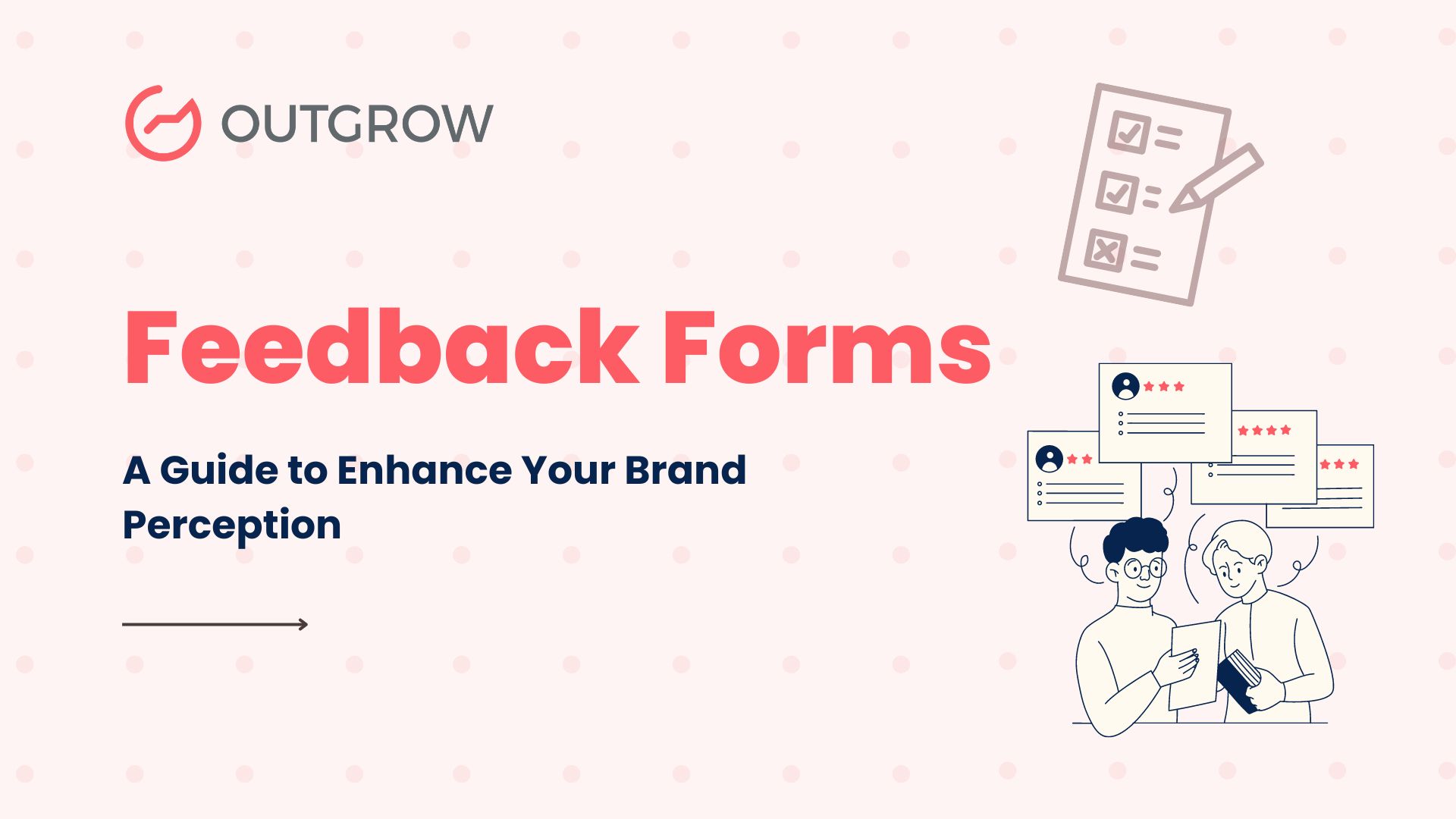Feedback Forms: 8 Form Types + 10 Easy Steps to Create
Table of Contents
Everybody wants to know what people think about them. The same goes for businesses as well. Brand perception is significant for all types of businesses. Understanding how your brand is perceived through feedback forms can make or break your success. It’s not just about having a great product or service; it’s about how customers perceive and connect with your brand.
When customers like you, they tend to stick around, recommend it to others, and even buy more. On the other hand, if customers don’t like you, they might leave and say bad things about it, which can harm your overall reputation.
To manage a brand — its reputation, customers, sales, etc. — getting and understanding feedback is more important than ever. That’s where Feedback Forms come in. These forms give customers a structured way to share their thoughts, helping businesses collect and understand valuable insights.
In this blog, we’ll explore various types of feedback forms, their advantages, and best practices to help you achieve the best results from your efforts.
But first, let’s take up a more fundamental question, shall we?
What Are Feedback Forms?
Feedback forms are tools designed to collect opinions and insights from individuals about a particular product, service, experience, or event. These forms are commonly used in various contexts, including business, education, healthcare, and more. They are used to gather valuable information that can help decision-making, improvements, and strategic planning.
These forms play a crucial role in continuous improvement by providing organizations with valuable input from their target audience. They serve as a direct communication channel between the provider and the recipient.
Now that we understand what feedback forms are, let’s take a look at some of its examples.
Feedback Form Types and Examples
Here are some examples of these forms tailored to specific requirements:
1. Customer Satisfaction Feedback Forms
Customer satisfaction is the cornerstone of business success. These forms are designed to enhance the overall satisfaction levels of customers. They cover aspects like product quality, service efficiency, and overall customer experience.
You can take a look at Airbnb’s customer satisfaction form for example:
Here they ask just a couple of questions to the users to understand their satisfaction levels while using the platform’s services.
2. Customer Support Feedback Forms
For businesses providing customer support services, these feedback forms help assess the quality of interactions between customers and support teams. Feedback is usually taken on response times, problem resolution, and the helpfulness of support representatives.
Take a look at Amazon’s customer support form.
Here they have provided just a simple yes or no as response options for users and a comments section as well for them to describe their experience if they want to.
3. Employee Feedback Forms
Employee feedback forms are crucial for understanding the sentiments of the workforce. These forms cover topics like job satisfaction, work environment, and opportunities for professional development. They provide insights that aid in fostering a positive workplace culture.
You can take a look at Starbucks’ partner experience survey.
Last held in November 2023, this form collected the feedback of over 130000 partners.
4. Market Research Feedback Forms
Market research forms play a vital role in gathering opinions on market trends, consumer preferences, and competitor analysis. This type of form is instrumental in shaping strategic decisions and ensuring businesses stay in sync with the latest developments in their industry.
You can take a look at Outgrow’s target market survey for example.
This feedback survey can be leveraged by brands to understand their target market. This essentially enables them to tailor their products and content according to their target market, resulting in higher engagement and conversion rates.
5. Healthcare Feedback Forms
In the healthcare industry, patient experiences matter. Healthcare feedback forms collect valuable insights on the quality of medical care, patient satisfaction, and the effectiveness of healthcare services. This information is invaluable for continuous improvement in healthcare delivery.
You can take a look at Outgrow’s patient feedback survey for example.
Here, the patients are requested to share feedback regarding the care they received from the Healthcare service provider. This enables the service provider to analyze and optimize according to the needs and expectations of their patients.
6. Event Feedback Forms
Event feedback forms are used post-events to gather feedback from attendees. These forms assess overall satisfaction, the relevance of content, and the effectiveness of the event’s aim. Event organizers use this feedback to enhance future events.
You can take a look at Outgrow’s post-event feedback survey.
Here the attendees are requested to share their feedback regarding the event they attended. They share their feedback on various aspects of the event such as the quality of the speakers, workshops, food, and more. The data collected from the form enables the organizers to optimize the shortcomings and ensure better events in the future.
7. Product Feedback Forms
Tailored for businesses offering products, these forms delve into user experiences and specific features. Likert scales and open-ended questions may be included to gather detailed insights, guiding product development and improvements.
You can take a look at Outgrow’s price testing survey for example.
This type of form can used by e-commerce platforms looking to analyze the sentiments and feedback of their customers regarding the pricing of their products. This can help them get a better understanding of the spending patterns and financial approach of their customers towards their products.
8. Educational Feedback Forms
Educational feedback forms are used in academic settings to gather input on courses, instructors, and the learning environment. Students can provide feedback on the effectiveness of teaching methods and the relevance of course content.
These are just a few examples, but these forms can be customized to suit the unique needs of each situation. Whether aiming to enhance customer satisfaction, improve employee engagement, or refine products and services, the right form empowers organizations with valuable insights for informed decision-making.
Still not convinced, eh?
Reasons to Use Feedback Forms
Here are compelling reasons to incorporate these forms into your strategy:
1. Measure Customer Satisfaction
Feedback forms provide a structured approach to measure and understand how satisfied customers are with products, services, or overall experiences. This metric is foundational for building lasting relationships and fostering brand loyalty.
2. Identify Areas for Development
To evolve and stay competitive, organizations need to pinpoint areas that require improvement. These forms act as diagnostic tools, highlighting specific aspects of products, services, or processes that may need refinement or enhancement. This proactive approach fuels continuous development and innovation.
3. Optimize User Experience
Feedback forms tailored to user experience help businesses evaluate the ease of use, functionality, and design of websites, applications, or products. By understanding user perspectives, organizations can make informed enhancements for an optimal customer journey.
4. Gain Insights for Strategic Planning
Strategic planning requires a solid foundation of data and insights. These forms play an important role in providing actionable information that guides strategic decision-making. By understanding customer preferences, market dynamics, and internal strengths and weaknesses, organizations can formulate effective and informed strategies.
5. Build Customer Loyalty
Customer loyalty is cultivated through positive experiences and a strong connection with a brand. These forms contribute to this by allowing customers to express their opinions and feel heard. Implementing changes based on customer feedback demonstrates a commitment to their satisfaction, and fosters loyalty.
Now that you have understood the importance of incorporating feedback forms into your marketing strategy, let’s take a look at some of the best practices to be kept in mind while doing so!
Best Practices to Follow While Using Feedback Forms
Implementing feedback forms effectively involves adopting best practices to ensure meaningful, accurate, and actionable insights. Here are key practices to consider:
1. Clearly Define Objectives
Before crafting a feedback form, define clear objectives. Define what specific information or insights you aim to gather. This clarity ensures that questions align with your goals, making the collected feedback actionable.
2. Keep Forms Simple and Concise
Respect users’ time by keeping forms concise. Avoid overwhelming them with lengthy forms. Focus on essential questions that directly contribute to your objectives, enhancing the likelihood of participation and honest responses.
3. Offer a Neutral Option
Include neutral response options, such as “Neither Agree nor Disagree,” in your feedback forms. This provides users the flexibility to express a lack of strong opinions, contributing to more accurate feedback.
4. Incentivize Your Form
Encourage participation by offering incentives and leveraging gamification. Whether it’s discounts, exclusive content, or entry into a giveaway, incentives can motivate users to complete the form, leading to a higher response rate.
5. Provide Open-Ended Options
Balance closed-ended questions with open-ended options to allow users to provide detailed insights. Additionally, avoid biased language or double-barreled questions to prevent influencing responses and maintain the integrity of the feedback.
6. Test the Form Before Launch
Conduct thorough testing with a small group before launching the feedback form to a broader audience. Testing helps identify any issues with questions, response options, or the overall flow of the form, ensuring a smoother experience for users.
7. Distribute the Form Through Multiple Channels
Maximize reach by distributing your form through multiple channels. Utilize email, social media, website pop-ups, and other relevant emerging platforms to engage a diverse audience and capture different perspectives.
8. Analyze the Data and Optimize
After collecting responses, analyze the data systematically. Identify trends, patterns, and areas for improvement. Use these insights to optimize products, services, or processes, ensuring a continuous enhancement loop.
9. Make Forms Interactive and Visually Engaging
Enhance respondent engagement by making the forms visually appealing and interactive. Utilize color schemes, clear layouts, and interactive features to maintain interest and encourage thoughtful responses.
By following these best practices, organizations can leverage feedback forms as powerful instruments for collecting valuable insights and fostering engagement.
Well, even after gaining all this knowledge about feedback forms, it won’t be of any use if we don’t know how to create one!
How to Create Interactive Feedback Forms
Outgrow, a no-code tool provides a dynamic platform for creating engaging and interactive feedback forms. Follow these steps to craft compelling forms that captivate your audience:
1. Navigate to Outgrow’s Dashboard
Log in to your Outgrow account and navigate to the dashboard. If you’re new to Outgrow, create an account to access the platform’s powerful features for interactive content creation.
2. Select Your Interactive Content Type
Outgrow offers a variety of interactive content types tailored for different purposes. You can try them as well, but for now, let’s choose “Form/Survey”
3. Select Your Desired Form Template
Outgrow offers a variety of templates tailored for different purposes, ensuring you start with a foundation that suits your feedback objectives. You can choose the template style that suits you the most. You even have the option to use a premade template or create your own from scratch without coding!
4. Add Your Branding
On the Outgrow form builder dashboard, you’ll see an edit bar on the left and a preview on the right.
This is where you can add your personal touch by adding a welcome message, personalized images, and your brand logo. Design your form with ease, using the real-time preview to see your work in progress.
Forms are centered around your questions, and Outgrow enhances the creativity of the form builder with a variety of question types to choose from.
Explore the Types of Questions
Choose the question type that aligns perfectly with the nature of your form. Outgrow provides a range of options to suit your specific needs.
5. Apply Logic Jump
Leverage Outgrow’s Logic Jump feature in your interactive form. Customize the user experience based on users’ previous answers, creating a personalized and engaging journey through the feedback process.
6. Lead Generation
When you create a feedback form, wouldn’t it be ideal to collect not just responses but also valuable lead details? The form builder has you covered by offering an option to include a lead generation form in your survey.
7. Thank You Page
Now, as we reach the final impression moment, seize the opportunity to captivate your audience with compelling videos or enticing offers.
Additionally, you can showcase your stellar work by linking your social media handles on this page.
8. Email Configuration
If you’ve successfully gathered some lead information, leverage the form builder software to send them personalized emails. Easily configure it on the form builder dashboard, and you’re good to go.
Explore more about email notification options in Outgrow here!
9. Embedding
Lastly, it’s time to set your form in motion by strategically placing it across various sections of your website. The embedding feature allows you to showcase your form through pop-ups, chat, or custom embeds, providing a more interactive approach to engaging your audience.
10. Preview and Test Your Form
Finally, before publishing, use Outgrow’s preview feature to see how your interactive feedback form will appear to respondents. Test the form to identify any potential issues or areas for improvement.
And Voila!
You have created your interactive form with Outgrow in minutes!
Conclusion
From customer satisfaction to product feedback, the versatility of feedback forms extends across various domains, providing tailored solutions to diverse needs. Incorporating feedback forms into your strategy offers a multitude of benefits, from measuring customer satisfaction to building customer loyalty.
By leveraging platforms like Outgrow, you can provide a user-friendly solution. By following a simple process, you can craft engaging forms, leveraging features like Logic Jump and lead generation to enhance the interactive experience.
And the best part is that Outgrow is offering a 7-day free trial where no credit info is required!
So, what is stopping you now?
Create your interactive feedback form with Outgrow today!
FAQs

Prajwal is a full-time content marketer at Outgrow. With strong expertise in thorough research, he loves to stay up-to-date with the latest marketing trends and technological developments. Outside of work, you’ll find him embracing the great outdoors; from grilling to thrilling physical activities, he’s always up for a good time.



